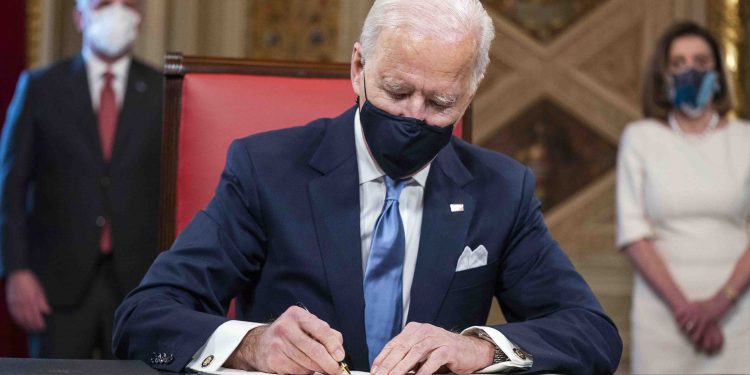Washington: The United States Congress approved the landmark USD 1.9 trillion COVID-19 relief bill Wednesday, as President Joe Biden and Democrats claimed a major triumph on legislation marshalling the government’s spending might against twin pandemic and economic crises that have upended a nation.
The House gave final congressional approval to the sweeping package by a near party line 220-211 vote precisely seven weeks after Biden entered the White House and four days after the Senate passed the bill.
Republicans in both chambers opposed the legislation unanimously, characterising it as bloated, crammed with liberal policies and heedless of signs the crises are easing.
“Help is here,” Biden tweeted moments after the roll call, which ended with applause from Democratic lawmakers. Biden said he’d sign the measure Friday.
Most noticeable to many Americans are provisions providing up to USD 1,400 direct payments this year to most people and extending USD 300 weekly emergency unemployment benefits into early September. But the legislation goes far beyond that.
The measure addresses Democrats’ campaign promises and Biden’s top initial priority of easing a one-two punch that first hit the country a year ago. Since then, many Americans have been relegated to hermit-like lifestyles in their homes to avoid a disease that’s killed over 525,000 people — about the population of Wichita, Kansas — and plunged the economy to its deepest depths since the Great Depression.
“Today we have a decision to make of tremendous consequence,” said House Speaker Nancy Pelosi, D-Calif., “a decision that will make a difference for millions of Americans, saving lives and livelihoods.”
For Biden and Democrats, the bill is essentially a canvas on which they’ve painted their core beliefs — that government programs can be a benefit, not a bane, to millions of people and that spending huge sums on such efforts can be a cure, not a curse. The measure so closely tracks Democrats’ priorities that several rank it with the top achievements of their careers, and despite their slender congressional majorities there was never real suspense over its fate.
They were also empowered by three dynamics: their unfettered control of the White House and Congress, polls showing robust support for Biden’s approach and a moment when most voters care little that the national debt is soaring toward a stratospheric USD 22 trillion. Neither party seems much troubled by surging red ink, either, except when the other is using it to finance its priorities, be they Democratic spending or GOP tax cuts.
Republicans noted that they’ve overwhelmingly supported five previous relief bills that Congress has approved since the pandemic struck a year ago, when divided government under then-President Donald Trump forced the parties to negotiate. They said this one solely reflected Democratic goals by setting aside money for family planning programs and federal workers who take leave to cope with COVID-19 and failing to require that shuttered schools accepting aid reopen their doors.
“If you’re a member of the swamp, you do pretty well under this bill. But for the American people, it means serious problems immediately on the horizon,” said House Minority Leader Kevin McCarthy, R-Calif., referring to the added federal borrowing the measure will force.
Even so, Sen. Roger Wicker, R-Miss., touted the bill’s $29 billion for the ailing restaurant industry, tweeting it would help them “survive the pandemic” without mentioning he had voted against the legislation. Democrats predicted this week that Republicans would do that, with Pelosi saying, “It’s typical that they will vote no and take the dough.”
Wicker told reporters, “I’m not going to vote for USD 1.9 trillion just because it has a couple of good provisions.” A dominant feature of the 628-page bill is initiatives making it one of the biggest federal efforts in years to assist lower- and middle-income families. Included are expanded tax credits over the next year for children, child care and family leave — some of them credits that Democrats have signaled they’d like to make permanent — plus spending for renters, feeding programs and people’s utility bills.
Besides the direct payments and jobless-benefit extension, the measure has hundreds of billions for COVID-19 vaccines and treatments, schools, state and local governments and ailing industries from airlines to concert halls. There is aid for farmers of colour, pension systems and student borrowers, and subsidies for consumers buying health insurance and states expanding Medicaid coverage for lower earners.
“Who’s going to help? Do we say this is all survival of the fittest? No,” said House Budget Committee Chairman John Yarmuth, D-Ky. “We rise to the occasion. We deliver.” The legislation would reduce the number of people living in poverty this year by around one-third, from 44 million down to 28 million, the liberal-leaning Urban Institute estimated Wednesday. The poverty rate for children would be reduced by over half, said the institute, which examined the impact of the measure’s stimulus checks, jobless benefits, food stamps and tax credits for children.
Rep. Jared Golden of Maine was the only Democrat to oppose the measure. He said some of the bill’s spending wasn’t urgent.
The measure was approve amid promising though mixed signs of recovery.
AP






































